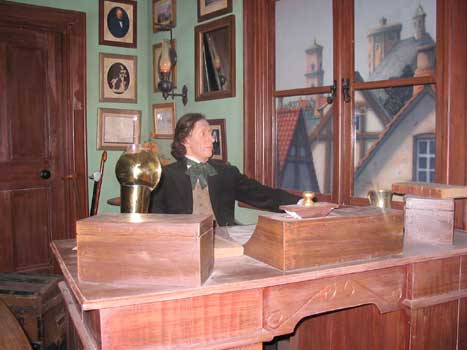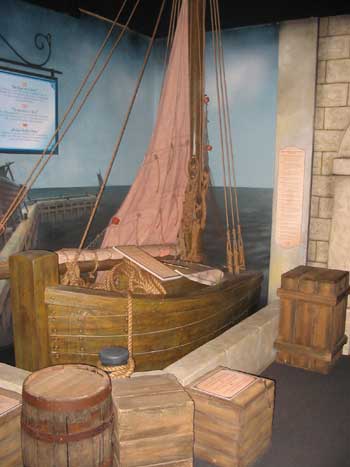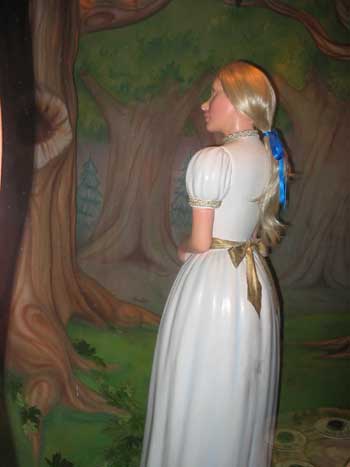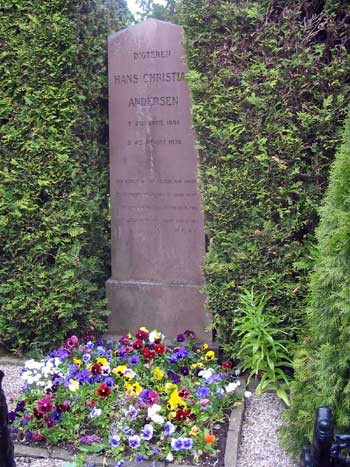
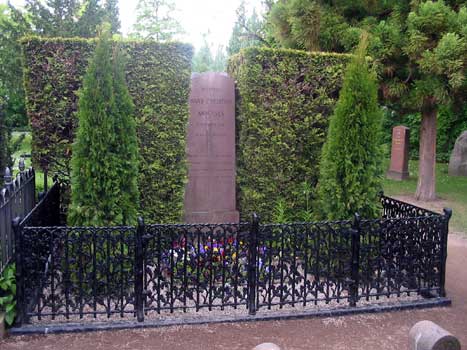

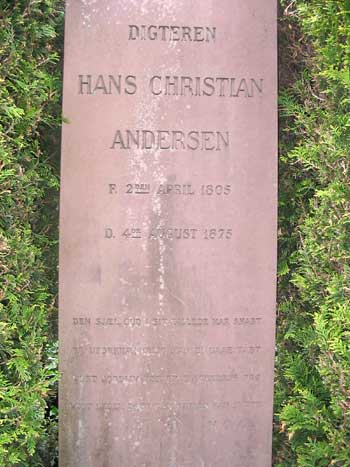

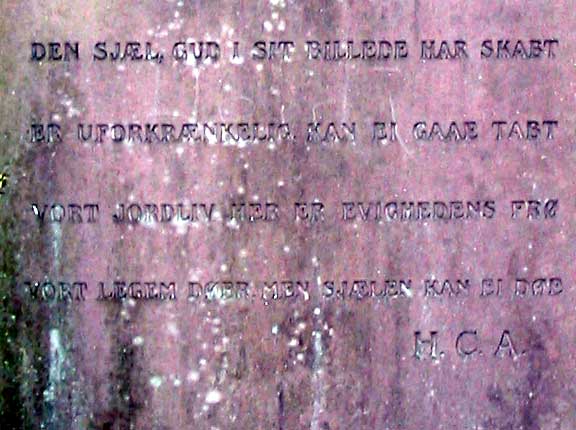

Hans Christian
Andersen was a product of two towns, two social environments, two worlds and
two ages. Both as a man and as a writer he thus continually developed and
changed, but was also in constant dialogue with himself and even at times at
war with himself. Thus his social rise provides the direct and indirect
motif in many of his tales, novels and plays, both as a productive source in
his search for a new and more comprehensive identity and as a source of
perpetual and unresolved traumas.
Two Towns
The two towns which had such a decisive influence on him were his
native town of Odense, and Copenhagen, where he lived and worked for the
greater part of his adult life.
As a poor child in the small but self-satisfied provincial centre of
Odense, Andersen received throughout the first 14 years of his life
impressions and experiences that were to be crucial for his literary
production. In the autobiography of his youth,
Levnedsbogen (not published till 1926), Andersen emphasised that
the way of life in Odense had preserved popular old customs and
superstitions unknown in Copenhagen and was therefore available to him as a
colourful stimulus to his imagination. However, even more crucial were the
disturbing social experiences from the lowest ranks of society and his own
urge to cast off the trammels of poverty, break with his social inheritance
and realise his potential in the only outlet the times provided, the world
of art, an urge that became ever more dominant throughout his childhood.
Furthermore, the elderly female inmates at Odense Hospital (the workhouse)
told him the folk-tales that were later to provide a starting-point for his
paraphrases of the old stories and for the tales he created himself. In this
respect Andersen also stands between two worlds: the popular old oral
narrative tradition and the modern world with its culture of books and focus
on the role of the author.
A decisive factor that determined the direction of Hans Christian
Andersen's life and his fantastic flight to Copenhagen in 1819, with the
social and literary rise that followed, is the fact that, as the only town
outside the capital, Odense had a theatre. In addition to his early escape
into the world of reading (his
father,
the poor shoemaker Hans Andersen, owned books, among them the Bible,
Holberg's comedies and the Arabian Nights), he was in contact with
the theatre (including travelling players from the Royal Theatre in
Copenhagen) and this provided knowledge and direction to Andersen's dreams
and aspirations. He left home as a 14-year-old on
4 September 1819, a few months after his confirmation, to seek his
fortune at the theatre in Copenhagen. Although this venture was unsuccessful,
Andersen was tied to the theatre for the rest of his life, as the author of
numerous plays and as the translator and adapter of foreign plays. The
theatre became his fate, so it can truly be said that if he had been born in
any other Danish provincial town, his career would never have been the same.
During Andersen's first years in Copenhagen (1819-22), he fought
desperately to gain a foothold in the theatre as a ballet-dancer, actor or
singer. Finally, when none of these attempts succeeded, he tried his hand as
a playwright; this was also in vain, but resulted in the director's deciding
to send him to
school so that something proper might be made of him, and this
experience was thus as crucial for his later life and work as the Odense
years. In Copenhagen he gained access to two families -
the Collins and the Wulffs - who were to become his spiritual kin. Here,
too, he came to know both the bourgeois upper class of the capital and the
very lowest stratum of its proletariat. He came to know the fight for
survival at subsistence level and the bitterness of being a supplicant
dependent on the goodwill of others.
Having left Odense and opted for art, Andersen had only one option: to
get up and get on. However, this was exactly the point at which he
experienced the suffering and humiliation that come from leaving one world
without having quite been accepted by another and higher one, an experience
shared by the Little Mermaid (1837) and the protagonists in Andersen's novel
O.T. (1836) and his play The Mulatto (1840).
Nevertheless, after his school years in Slagelse and Elsinore, Copenhagen
also came to mean something positive in his development: here the
proletarian Andersen acquired the culture and education associated with
bourgeois circles in the Golden Age that encompassed the last years of
absolute monarchy, and Andersen, fundamentally sensitive and sentimental,
learned to use the light and ironic Copenhagen wit, particularly the lethal
form he knew from the Collin family and from the dominant circle around the
dramatist and critic Johan Ludvig Heiberg. Andersen's entire production of
tales is, as it were, suspended between these two poles, heart and wit,
sensitivity and irony, nature and culture, creating a field of tension that
finds its expression as early as in his tour de force, Fodreise
fra Holmens Canal til Østpynten af Amager i Aarene 1828 og 1829 (A
journey on foot from Holmens Canal to the east point of Amager in the years
1828 and 1829), his
first work, which was published in 1829.
Denmark and Europe
Andersen's journey or flight from Odense to Copenhagen was continued as a
lifetime of shuttling between Denmark and the rest of Europe, where Germany,
in particular, became his second home. At the same time his journeying paved
the way for international literary fame. Andersen also felt at home
temperamentally elsewhere in Europe, Italy especially leaving him with
decisive impressions of nature, popular life and art. Andersen had a very
ambivalent relation to Denmark, a country he could not do without, but which
he sometimes detested thoroughly for its pettiness. He was the first great
victim of what was later to be known as the
Jantelov, a victim closely followed by Søren Kierkegaard in the
later phases of his work. But in contrast to Kierkegaard, who never
travelled further afield than Berlin, Andersen became the most widely
travelled Danish writer of his day. Altogether he went on 29 trips abroad
and all in all spent over 9 years of his life outside Denmark.
Travel books.
The
FAQ on travels.
Two Ages
With his rise from the bottom of society to the top, Andersen gradually came
to be a regular guest at Danish and foreign manor houses and at the
residences of kings and princes in Denmark and abroad. Thus Andersen's life
became a paradigm for the social mobility that was only really brought about
by bourgeois democracy following the signing of the constitution in 1849.
Andersen's life and work are firmly rooted in the culture of the last years
of absolute monarchy, but as a social outsider, one who had had to acquire
the ideas inherent in the culture of the times, he became more modern and
progressive in his ideas than the majority of contemporary Danish writers.
He had every reason to reject the Romantics' worship of the past as "the
glorious peak, from which we have fallen, but now again seek" (Adam
Oehlenschläger), and instead to place all his hopes in future developments.
Throughout his oeuvre Andersen put his trust in a movement in the
direction of increased humanity and enlightenment (see, for example,
chapters VI and IX in his travel book Rambles in the Romantic Regions of
the Hartz Mountains, Saxon Switzerland, &c. (1831) and his story "Godfather's
Picture Book" (1868)), just as he enthusiastically learned to profit from
the revolution with respect to the means of travel (see his ode to the
railway in the eponymous chapter in his travel book A Poet's Bazaar
(Danish ed. 1842)), communication (the telegraph, which he thought would
turn the world into "a single spiritual state", just as we envisage the
Internet doing today) and industry (see his article "Silkeborg" (1853)).
This article, like the stories "The Ice Maiden" (1862) and "The Dryad"
(1868), reveals that sometimes he could view developments more
pessimistically. Particularly because everywhere in his work, he appears as
a spokesman of "nature" as the great measure of value, particularly in his
perception of art and literature (see
tales like "The Nightingale" (1843), and "The Bell" (1845).
From a literary as well as a mental and political point of view Andersen
thus spans two cultures, two ages, two social systems and two literary
periods (Romanticism and the dawn of Realism).
Religious Observance
His religious feeling, which provides an undertone to all that he wrote,
stems from an undogmatic sort of Christianity, a religion of the heart and
the emotions bound to human nature and to the natural world around us as a
starting point for the yearning for God (see "The Little Mermaid" (1837) and
"The Last Dream of the Old Oak Tree" (1858)). In his religious attitude
Andersen was anything but childish or naive (as he has often been accused of
being). His attitude can be seen, for instance, in the chapter "Tro og
Videnskab. Prædiken i Naturen" (Faith and science. A sermon inspired by
nature) in his travel book Pictures of Sweden (1851). This work
also contains his statement of belief in the unification of nature and
poetry, a belief inspired by his friend H.C. Ørsted, in the chapter "Poesiens
Californien" (The California of Poetry). Similar statements can be found in
the religious expository novel To Be, or Not to Be? (1857) and the
chapter "Cordoba" in the travel book In Spain (Danish ed. 1863).
However, Andersen's faith was not unchallenged. Spread throughout his
diaries,
stories and
novels are also many expressions of bitterness, scepticism, existential
angst and emptiness, for instance in the novel Only a Fiddler
(da. 1837), the fairy-tales "The Shadow" (da. 1847), "The Fir Tree" (da.
1844), "Aunty Toothache" (da. 1872), "The Wind Tells about Valdemar Daae and
His Daughters" (da. 1859) and the poem "Psalme" ("Hymn", da. 1864), which is
now admitted to the Danish hymn book.
Fame
Andersen's literary fame grew rapidly from the mid-1830's, when his
novels enjoyed widespread circulation in Germany. From 1839 onwards it
was the
fairy-tales that created his quite exceptional reputation in that
country. It is from the mid-1840's that we date the great breakthrough in
England and America for both tales and novels.
The FAQ on geographic spread of interest.
Honorary Citizen
Andersen had only occasionally revisited his native town of Odense since his
youth. However, in 1867, when
he was made a titular Councillor of State, Odense wished to contribute
to the celebration of a famous son and granted him
the freedom of the town in December that year. This event brings to an
end the annalistic sequel to Andersen's
autobiography The Story of My Life (original ed. 1855, the
sequel is from 1869).
The Workers' Association
It contributes to our picture of Hans Christian Andersen that he attached
great importance to the fact that he was the first Danish writer to break
the ice and accept an invitation to read from his own tales to the newly
formed Workers' Association of 1860. Throughout the last 20 to 25 years of
his life he read in turn to the Students' Association, the Workers'
Association, to the Royal Family, the seamstresses, and the nobility and
gentry. In the Workers' Association, he encountered an enthusiastic audience
- often 500 to 1,000 people at a time - and he read to them about 20 times.
For this reason he was repeatedly acclaimed by the Workers' Association,
whose members also - together with the Students' Association - formed a
guard of honour at his
funeral in the Cathedral of Copenhagen.
Burial Place
Andersen is buried at Assistens Kirkegård in Copenhagen in a burial plot he
originally shared with his friend, Edvard Collin, and Collin's wife,
Henriette. Around 1920, when certain public criticisms arose concerning the
Collins´treatment of their "adopted son", Andersen, a descendant of the
Collin family had Edvard and Henriette's tombstone moved to the family plot,
so that Andersen's tombstone now stands alone.
Pictures from The Museum of Hans Christian Andersen in Copenhagen:

